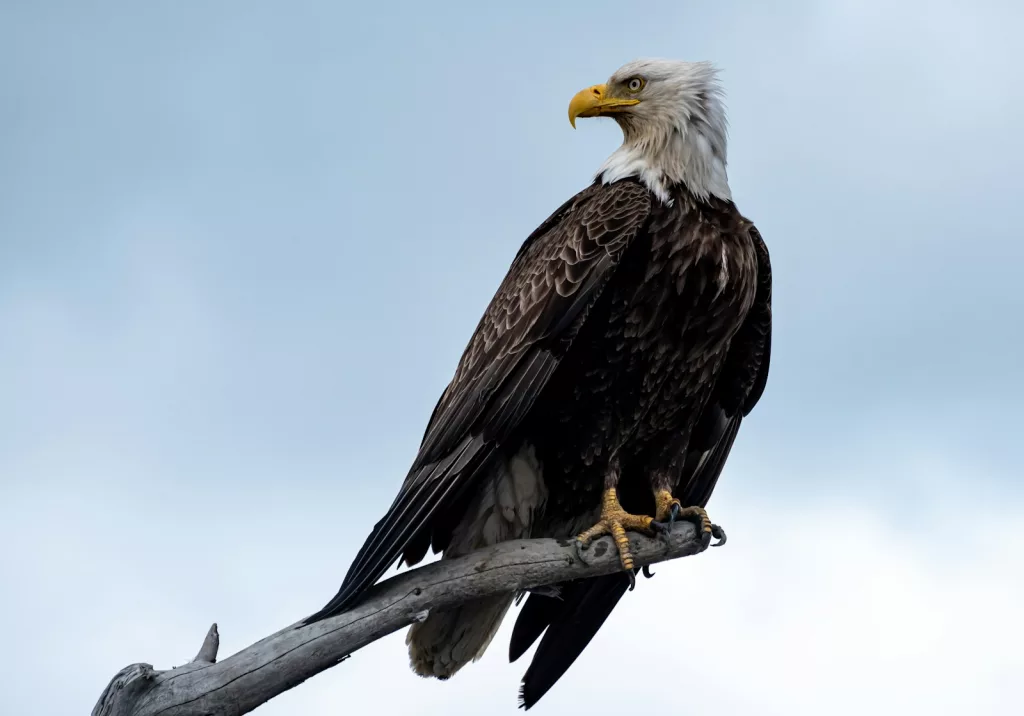15 Surprising Facts About Eagles That Will Captivate Your Attention

Eagles are among the most majestic and powerful birds in the world, symbolizing freedom and strength across cultures. These incredible creatures boast extraordinary physical capabilities, fascinating behaviors, and a vital role in ecosystems. Here are 15 surprising facts about eagles that are sure to captivate your attention and deepen your appreciation for these remarkable birds.
1. Eagles Have Exceptional Vision
Eagles are renowned for their extraordinary eyesight, which is among the best in the animal kingdom. Their eyes have a density of light-detecting cells that is five times greater than humans, allowing them to spot prey from up to two miles away. This unparalleled vision is further enhanced by a second fovea, a specialized structure in their retinas that helps them focus on distant objects with remarkable precision.
This extraordinary visual capability is essential for hunting, as eagles rely heavily on sight to locate prey from great heights. Combined with their ability to perceive ultraviolet light, this gives them an advantage in tracking movement and distinguishing potential meals from their surroundings. Their exceptional eyesight truly makes them masters of the skies.
2. They Are Built for Speed and Agility
Eagles are not just strong flyers; they are incredibly fast and agile predators. Depending on the species, an eagle can reach speeds of up to 100 miles per hour during a dive. This high-speed precision allows them to catch prey off-guard, showcasing their unparalleled hunting skills.
Their broad wings and powerful muscles make them capable of soaring for hours without expending much energy. This efficient flight capability is critical for scanning large areas in search of food. Their agility in the air also enables them to navigate complex environments and defend their territories against intruders.
3. Bald Eagles Aren’t Actually Bald
Despite their name, bald eagles are not bald. The term “bald” originates from the old English word “balde,” meaning white, and refers to their striking white head feathers. This distinctive feature contrasts sharply with their dark brown bodies and wings, giving them their iconic appearance.
The bald eagle’s striking plumage is not just for show—it plays a significant role in identification and mating. The bright white feathers signal maturity and health, which are key factors in attracting a mate. This symbolic appearance has also made them one of the most recognized and celebrated birds in North America.
4. They Bond for Life
Eagles are known for their strong pair bonds and lifelong monogamous relationships. Once an eagle finds a mate, the pair works together to build large nests, called eyries, often in tall trees or cliffs. These nests are constructed from sticks and lined with softer materials such as grass and feathers to provide a safe environment for their offspring.
Over the years, eagles return to the same nest, adding new materials each breeding season. Some nests can reach impressive sizes, with the largest recorded weighing over two tons. This commitment to their partner and their shared territory underscores the eagle’s reputation for loyalty and teamwork.
5. Eagles Have Powerful Talons
An eagle’s talons are incredibly strong, designed specifically for gripping and subduing prey. With a grip strength of up to 400 pounds per square inch, their talons can easily catch and carry prey that may weigh almost as much as they do. These sharp claws are essential tools for hunting and self-defense.
Eagles use their talons not only to capture prey but also to protect their territory and fend off predators. The sheer power and precision of their grip make them one of the most efficient predators in the avian world. This ability highlights their dominance as apex predators within their ecosystems.
6. They Are Apex Predators
Eagles sit at the top of the food chain, making them apex predators with few natural enemies. Their diet primarily consists of fish, small mammals, and other birds, but they are also opportunistic hunters, adapting to the resources available in their environment.
This predatory role is vital for maintaining ecological balance. By regulating populations of prey species, eagles help prevent overgrazing and ensure the health of their habitats. Their position as apex predators underscores their importance within the ecosystems they inhabit.
7. Some Eagles Build Enormous Nests
Eagles are renowned for constructing some of the largest nests of any bird species. These structures, often located in tall trees or on cliffs, can span up to 9 feet in diameter and weigh over 2,000 pounds. Bald eagles, in particular, are famous for their massive nests, which they expand over many years of use.
The impressive size and durability of these nests reflect the eagle’s dedication to providing a secure environment for their young. Nests are carefully lined with soft materials to cushion eggs and chicks, ensuring their safety and comfort. This remarkable nesting behavior showcases the eagle’s commitment to its offspring.
8. Eagles Can Live for Decades
In the wild, eagles can live up to 20-30 years, with some individuals reaching even greater ages in captivity. This long lifespan is a testament to their adaptability and resilience, as they face challenges such as habitat loss and changing climates.
Their extended lifespan allows eagles to play a significant role in their ecosystems over many years. As experienced hunters and territorial defenders, older eagles contribute to the stability and health of their habitats, demonstrating their enduring impact on the natural world.
9. They Are Found Across the Globe
Eagles are incredibly versatile birds, inhabiting a wide range of environments across every continent except Antarctica. From the African savannas to the forests of North America and the mountainous regions of Asia, eagles have adapted to diverse habitats, showcasing their resilience and adaptability.
Each species of eagle has evolved unique characteristics suited to its environment. For example, the golden eagle thrives in open terrains, while the harpy eagle navigates dense rainforests. This global distribution underscores the eagle’s ability to survive and flourish in varied ecological conditions.
10. Eagles Symbolize Power and Freedom
For centuries, eagles have been revered as symbols of power, freedom, and vision. They appear prominently on flags, coats of arms, and currency in cultures around the world. The bald eagle, in particular, holds a special place in American culture as the national bird and a symbol of liberty.
This symbolic status reflects the eagle’s awe-inspiring presence and dominance in the natural world. Their ability to soar high above the earth has inspired humans to associate them with transcendence, strength, and the pursuit of greatness. Eagles continue to captivate and inspire across generations.
11. Juvenile Eagles Look Different From Adults
Young eagles often have mottled brown plumage that differs significantly from the distinctive appearance of adults. For example, juvenile bald eagles lack the iconic white head and tail feathers, which gradually develop over several years.
During this maturation period, young eagles learn essential survival skills such as hunting and defending themselves. The gradual transformation in their appearance signifies their growth and readiness to take on the responsibilities of adulthood in the wild.
12. They Communicate With Calls and Displays
Eagles use a variety of vocalizations and physical displays to communicate with one another. Their calls range from high-pitched whistles to harsh screeches, depending on the species and context. These vocalizations are often used to defend territory, attract mates, or signal distress.
In addition to vocal communication, eagles perform aerial displays that demonstrate their agility and strength. These behaviors are particularly prominent during courtship, where pairs engage in dramatic flights to strengthen their bond. Such displays highlight the eagle’s dynamic and expressive nature.
13. Eagles Can Fly at Extreme Altitudes
Eagles are capable of soaring to impressive altitudes, often thousands of feet above the ground. This ability is supported by their large lungs and efficient respiratory systems, which allow them to thrive in thin air.
Flying at such heights provides eagles with a strategic advantage for spotting prey and avoiding ground-based threats. Their high-altitude flights also demonstrate their unparalleled mastery of the skies, cementing their status as some of the most formidable birds in the world.
14. They Are Loyal to Their Territories
Eagles are highly territorial birds, often defending their nesting and hunting areas with great determination. They patrol their territories regularly and may engage in dramatic aerial battles with intruders to assert dominance and protect their resources.
This territorial loyalty ensures that eagles have consistent access to food and safe nesting sites. Their commitment to defending their territories underscores their role as dominant predators and stewards of their ecosystems.
15. Conservation Efforts Have Saved Many Eagle Species
Many eagle species have faced significant threats from habitat destruction, pollution, and hunting. However, concerted conservation efforts, including habitat protection and bans on harmful pesticides like DDT, have led to remarkable recoveries. The bald eagle, once on the brink of extinction in the United States, is now a conservation success story, with populations rebounding dramatically in recent decades.
These successes highlight the importance of conservation initiatives in protecting wildlife. By supporting policies and practices that safeguard eagles and their habitats, we ensure that future generations can continue to marvel at these extraordinary birds and the vital roles they play in nature.


